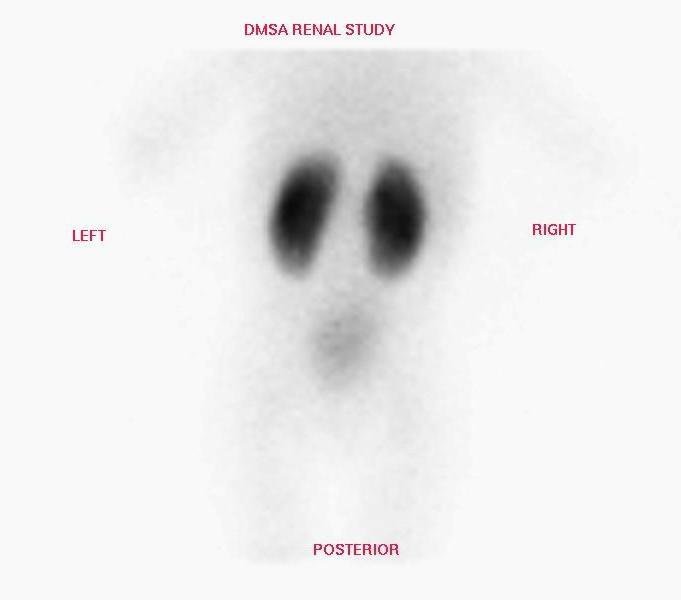A DMSA scan is one type of imaging test – a test that uses special equipment to create one or more pictures of part of the inside of the body.
This topic gives general information. The way these tests are performed will vary between different hospitals.
What is a DMSA scan?
A chemical called dimercaptosuccinic acid (DMSA) is injected into your child’s body. This chemical is taken into some cells in his or her body, such as those in the kidneys. DMSA is linked to a radioisotope. It emits (gives out), a type of radiation (source of energy) called gamma rays.
During the scan, a special camera picks up the gamma rays and turns them into pictures.
- The kidney cells (living parts) that are ‘active’ take up the DMSA and emit gamma rays. These are shown on the images as ‘hot spots’, and may be bright or in a colour.
- The kidney cells that are less ‘active’ (for example, are damaged) take up less or none of the DMSA, and do not emit as many gamma rays. These are shown on the images as less bright spots, or may not be seen at all.
Why does my child need this test?
A DMSA scan can look at the size, shape and position of your child’s kidneys, check for any scars or abnormal areas of development and find out how well one kidney is working compared to the other.

DMSA scan risks and complications
What are gamma rays?
Gamma rays are one type of ionising radiation, a form of energy. At high levels, they can be dangerous to humans because they can damage cells, the living parts of the body.
We are all exposed to ionising radiation – in our homes and workplaces (it is in some construction materials and it seeps from the ground into buildings), when we eat certain foods, and when we take a flight. However, this is at very low levels.
Are DMSA scans harmful?
A DMSA scan gives the same amount of radiation (dose) that we would be exposed to in between 6 months and one year. The radioisotope that is injected into your child’s body becomes inactive after a few hours and is passed out of his or her body in urine or faeces (poo). However, your doctor will carefully consider the risks and benefits of doing this test in your child.
How to prepare your child for a DMSA scan
Your child does not usually need to do anything to prepare for this test, but your doctor will let you know. This test takes several hours. Because of the long waiting times, you may want to bring books or toys for your child. Your doctor may ask whether your child has allergies to any medicines or contrast dye that may be used during the test.
Older girls may be asked if they are having their period, and about the dates of their last period. They may also be asked if they are pregnant or if they could be pregnant. This is because ionising radiation from X rays may harm an unborn baby. Sometimes your child may be asked to go to the toilet just before the scan to make sure his or her bladder is empty.
Your child may be able to meet with a play specialist, who can use dolls and other toys to help him or her prepare for the test.
What happens
The DMSA scan takes place in the nuclear medicine department of your hospital. A radiographer or a technician, a specialist trained in imaging tests, performs the test.
- The radioisotope is injected into a blood vessel, using a needle or a small plastic tube called a cannula. This is usually in the hand, arm or foot. Your child may feel a sharp scratch from the needle. A local anaesthetic, a spray or cream, can be put on your child’s skin before inserting the needle or cannula, to make the area feel numb.
- It takes some time for the radioisotope to reach the kidneys. Your child will wait for about three hours, and then come back to the nuclear medicine department.
- During the scan, your child lies on a scanning bed.
- Your child needs to lie still while a large camera above him or her takes pictures. These show the radioisotope that has been taken up by his or her kidneys.
What to expect afterwards
Your child may be asked to drink lots of water after the test. This will help ‘flush out’ the DMSA from his or her body more quickly. Your child can usually go home straight away.
There may be a small amount of DMSA in your child’s urine for 24 hours after the test.
- Your child should sit on the toilet to urinate (wee) for the day after the test. Make sure he or she washes his or her hands with water and soap.
- If your child uses nappies, put used nappies in a separate bag for 24 hours, then throw them away in your normal rubbish. Remember to wash your hands with water and soap.
- If your child accidentally wets his or her clothes or bedding, put these in a separate bag for 24 hours and then wash them as normal.
- Pregnant women should avoid direct contact with the child’s urine or faeces for 24 hours.
Getting the results
The radiographer or nuclear medicine technician performing the test will send a report to your doctor. Speak with your doctor about when you should expect the results.